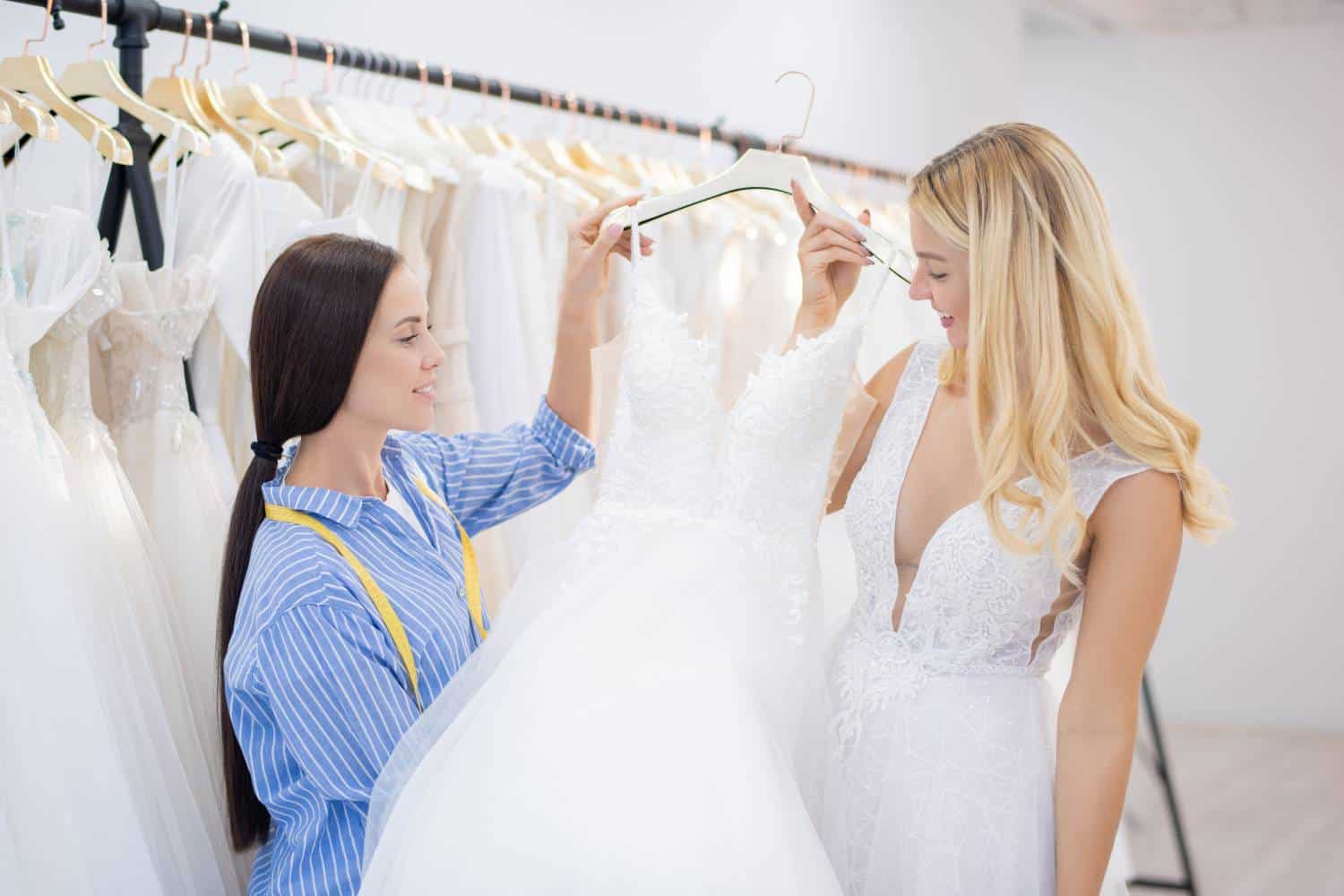Organising your wedding dress timeline is one of the most exciting aspects of wedding planning. To help you achieve your dream bridal look, we’ve put together a comprehensive, month-by-month guide.
This plan covers everything from your first inspiration to final fittings, ensuring your wedding dress journey is smooth and stress-free.
Let’s get straight to the point
For a flawless bridal look, start planning your wedding dress journey 12 months before the big day.
Begin by setting a budget, finalising your wedding date and venue, and researching dress styles. By 9-8 months, purchase your gown and arrange fittings.
At 6 months, pick accessories, shoes, and undergarments. Schedule fittings 5-3 months ahead, with a final fitting 2-3 weeks before the wedding.
A week out, pick up your dress and gather essentials the day before. After the wedding, decide whether to preserve or donate your gown. Follow this timeline to stay organised, confident, and beautiful on your special day.
12 Months Before the Wedding
Set Your Wedding Date and Venue
Setting the date and choosing a venue are critical first steps. Both elements directly impact your dress choice.
For instance, a formal ballroom wedding calls for a gown style different from that of a beachside ceremony. Locking in these details gives you a clear vision for your wedding dress search.
Establish Your Budget
Establishing a budget for your bridal look is essential. Take into account costs for the dress, accessories, alterations, and any delivery fees.
Remember to include items like shoes, veils, jewellery, and undergarments to avoid surprise expenses down the line.
Begin Researching Dress Styles
With your venue and budget in place, it’s time to start researching styles.
Browse bridal magazines, Pinterest boards, and online bridal shops to discover gowns that suit your body type and wedding theme. Consider fabrics suited to your season, and save any images or ideas that inspire you.
11-10 Months Before the Wedding
Start Shopping for Your Wedding Dress
Begin the search for your dream wedding dress. Book appointments at bridal boutiques and consider attending trunk shows, where you may find unique or exclusive designs.
Bringing one or two trusted companions along can help, but limit the group to avoid conflicting opinions.
Tip: Stay open-minded during dress shopping – sometimes, the gown you didn’t expect to love becomes “the one.”
9-8 Months Before the Wedding
Finalise and Purchase Your Wedding Dress
Once you’ve explored different styles and identified your favourite, it’s time to make your purchase.
Wedding dresses are often made to order, so purchasing at least nine months before your wedding is ideal. Expect to pay a deposit, often around 60% of the total dress cost.
Ensure all details, such as size and customisations, are documented in your contract, and clarify the expected delivery date.
Schedule Fittings
Once your dress order is confirmed, schedule your fittings well in advance. Most brides need two or three fittings to ensure a perfect fit.
6 Months Before the Wedding
Choose Your Accessories
With your dress chosen, it’s time to pick accessories. Will you have a veil? If so, select one that complements the length and style of your dress.
You may also want jewellery, a belt, or a headpiece to enhance your look. Make sure these pieces align with your overall wedding theme.
Buy Wedding Shoes
Shoes are a crucial part of your wedding look. Purchase your shoes early, as their height will affect dress alterations. Whether you choose heels or flats, spend time breaking them in to prevent discomfort on the big day.
Select Undergarments
The right undergarments can make all the difference. Depending on your dress, you may need a strapless bra, shapewear, or a petticoat. Ensure these are comfortable and functional, as they’ll be essential for a full day of wear.
5-4 Months Before the Wedding
Schedule Your First Fitting
Book your first fitting approximately three months before your wedding. At this fitting, major alterations—such as hemming and adjusting the bodice—will be completed. Bring your shoes and undergarments to ensure accurate measurements.
Attend Your First Fitting
Your first fitting allows you to see how the dress fits and feels. Walk around in it, sit down, and check the comfort level.
This is the time to make adjustments to the fit and discuss any concerns with your seamstress.
Pro Tip: If your dress has a train, discuss the bustle arrangement for the reception.
3 Months Before the Wedding
Finalise Accessories and Undergarments
By now, all accessories—including your veil, jewellery, and undergarments—should be finalised.
Verify that everything aligns with your dress and overall wedding theme. If you’re incorporating “something old, something new, something borrowed, something blue,” make sure these items are ready.
2 Months Before the Wedding
Schedule a Second Fitting
The second fitting is for fine-tuning. This session allows your seamstress to make minor adjustments and address any remaining issues with the hemline or neckline.
Bring all your accessories, including shoes and undergarments, so you can see how everything looks together.
Pro Tip: Have a friend or family member join you to learn how to bustle your dress.
1 Month Before the Wedding
Break in Your Wedding Shoes
To ensure comfort, spend time breaking in your wedding shoes. Walk around your home or go on short outings to identify any discomfort or potential blisters. Many brides opt for a second, more comfortable pair of shoes for dancing and the reception.
2-3 Weeks Before the Wedding
Attend Your Final Fitting
This final fitting is the last chance to adjust your dress for a perfect fit. Bring a trusted friend or family member to help with dressing on the big day and to ensure they’re familiar with any fastenings or bustle arrangements.
1 Week Before the Wedding
Pick Up Your Dress
Collect your wedding dress about a week before the wedding. Keep it in a breathable garment bag and store it in a clean, safe place. Avoid showing it to your fiancé, and if possible, leave it at the bridal salon until closer to your wedding date to prevent mishaps.
1 Day Before the Wedding
Gather Your Wedding Day Essentials
Prepare all wedding day essentials the night before. This includes your dress, shoes, veil, and accessories. Create a “survival kit” with items like a steamer, safety pins, and fashion tape for any last-minute fixes. Organising everything ahead of time helps the wedding day go smoothly.
The Wedding Day
Allow Ample Time to Get Ready
Getting into your dress may take longer than expected, especially if it has intricate fastenings. Allow extra time so you can stay calm and relaxed. Remember, this day is all about feeling beautiful and celebrating!
After the Wedding
Preserve or Donate Your Dress
After your wedding, decide whether to keep, donate, or sell your dress. If preserving it as a keepsake, have it professionally cleaned and stored in a preservation box.
If you prefer not to keep it, consider donating or selling it so another bride can enjoy your beautiful gown.
Conclusion
Planning your wedding dress timeline ensures a smooth journey to achieving your dream bridal look.
By starting early, staying organised, and following this month-by-month guide, you’ll feel prepared and confident on your wedding day.
With the right planning, you’ll step into your dress feeling beautiful, comfortable, and ready to enjoy every moment.
Frequently Asked Questions
What Are the 5 Things a Bride Needs?
The tradition is based on an Old English rhyme that dates back to 19th-century Lancashire.
It describes the items a bride should have on her wedding day: “something old, something new, something borrowed, something blue, a sixpence in your shoe.”
Do You Wear the Engagement Ring on Your Wedding Day?
Wear it on your right hand: While tradition suggests the ring should be worn on the left, placing it on your other hand won’t be a big problem.
This means you get all eyes on your wedding ring and after the ceremony, you can pop your engagement ring back onto the wedding finger.
What Is the Most Popular Color for Mother of the Bride Dresses?
When it comes to color choices, navy is the number-one most requested color for the mothers of the bride and groom. Other popular colors include blush and shades of nude. Traditionally, you want to avoid white, black and red.
What Mother of the Groom Should Not Wear?
It’s encouraged to steer clear of wearing white, blush or neutral hues that can look white on camera unless specifically approved by the bride. These shades may look similar to the bride’s wedding dress, and it’s always best to avoid any color mishaps.
What Color Should the Mother of the Bride Not Wear?
There’s not one specific color the mother of the bride should wear. It’s generally best to steer clear of white, ivory or champagne hues as to not take attention away from the bride.



